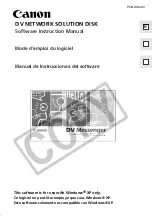Reviews:
No comments
Related manuals for pcAnywhere

70 MC - ZR70MC MiniDV Digital Camcorder
Brand: Canon Pages: 57

SESSION
Brand: M-Audio Pages: 6

gMovie v1.4
Brand: Generic Media Pages: 17

KEmul RS232
Brand: Baracoda Pages: 9

8.5 EMAIL SERVER EDITION - V 85.4
Brand: AVG Pages: 52

UPGRADE FIRMWARE MODEM ROUTER
Brand: Belkin Pages: 1

ATR 20/20
Brand: Acroprint Pages: 1

TRUE IMAGE CORPORATE WORKSTATION 8.0
Brand: ACRONIS Pages: 79

TRUEIMAGE DELUXE
Brand: ACRONIS Pages: 90

TRUE IMAGE 8.0
Brand: ACRONIS Pages: 97

AURORA INGEST 7
Brand: GRASS VALLEY Pages: 4

Aurora Browse
Brand: GRASS VALLEY Pages: 42

ImageServer
Brand: MINOLTA-QMS Pages: 42

PageScope
Brand: MINOLTA-QMS Pages: 60

VIDEOCAM SLIMCLIP
Brand: Genius Pages: 7

SAMREPORT-LITE 2005
Brand: Macrovision Corporation Pages: 44

REGISTRYBOOSTER 2010 - V1
Brand: UNIBLUE Pages: 11

010-10844-00 - Mobile XT - GPS Software
Brand: Garmin Pages: 52

















